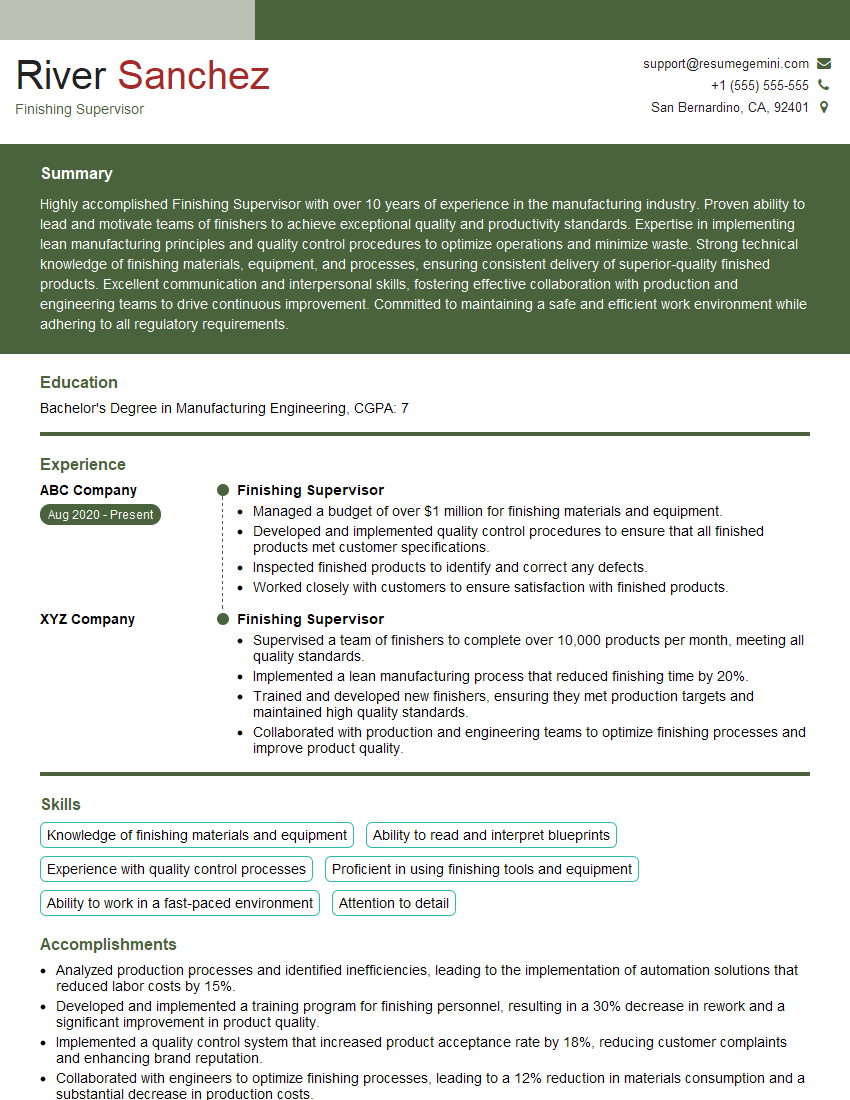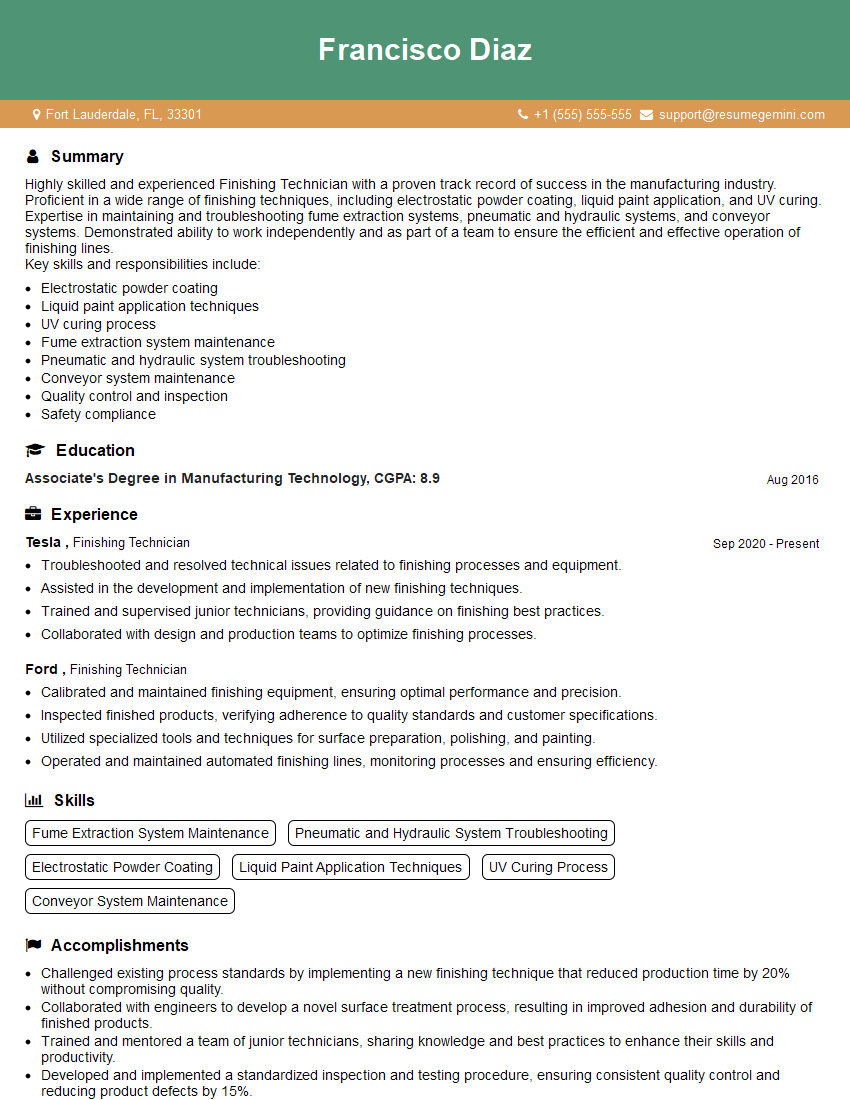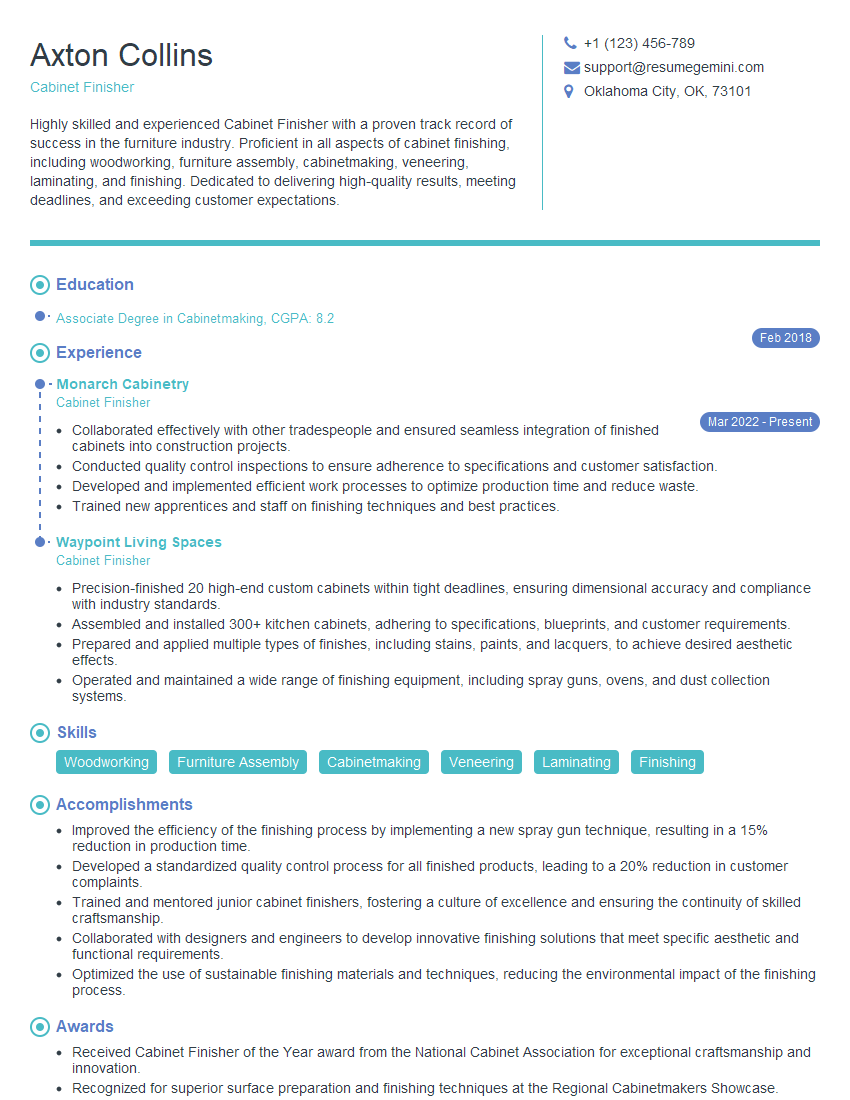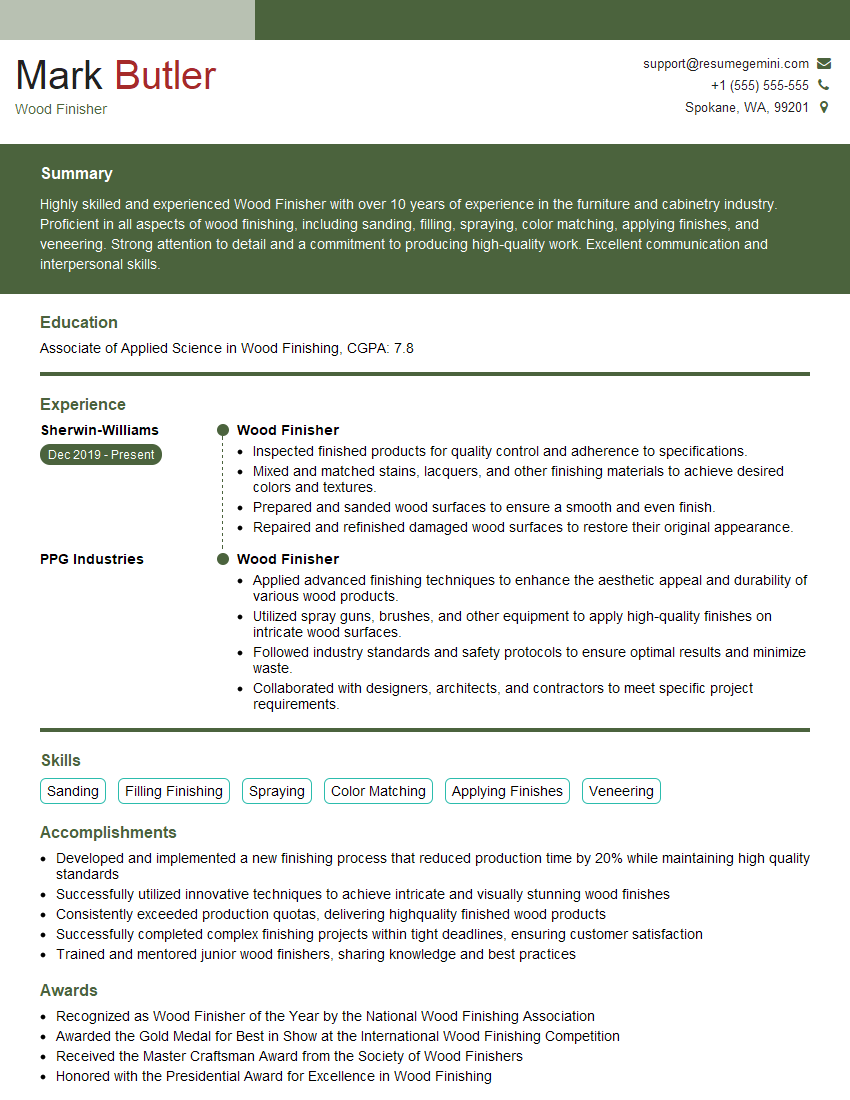Feeling uncertain about what to expect in your upcoming interview? We’ve got you covered! This blog highlights the most important Finishing Work interview questions and provides actionable advice to help you stand out as the ideal candidate. Let’s pave the way for your success.
Questions Asked in Finishing Work Interview
Q 1. Explain the difference between a solvent-based and a water-based finish.
The primary difference between solvent-based and water-based finishes lies in their composition and how they dry. Solvent-based finishes, like traditional lacquers and varnishes, utilize volatile organic compounds (VOCs) as solvents to dissolve the resin. These solvents evaporate, leaving behind the hardened resin film. Water-based finishes, on the other hand, use water as the solvent. Water evaporates, leaving the resin behind.
Solvent-based finishes tend to dry faster, offer superior durability and hardness in many cases, and often have a richer, glossier finish. However, they have stronger odors, require more careful ventilation during application, and the solvents can be harmful to the environment and human health. Think of older, traditional furniture polishes – many of these were solvent-based.
Water-based finishes are environmentally friendlier, have less odor, and are generally easier to clean up with soap and water. They are also often less expensive. However, they might dry slower and may not achieve the same level of hardness or gloss as solvent-based counterparts. Many modern, eco-friendly furniture finishes are water-based.
The choice between the two depends heavily on the project, the desired aesthetic, and environmental concerns.
Q 2. Describe your experience with various sanding techniques (e.g., hand sanding, power sanding).
My experience with sanding encompasses both hand sanding and power sanding techniques. Hand sanding, using various grits of sandpaper, allows for precise control and is crucial for detailed work, such as shaping curves or reaching intricate corners. I frequently use it for final sanding to achieve a perfectly smooth surface before applying the finish. It’s almost like sculpting the wood with the sandpaper, allowing you to feel for imperfections and address them directly.
Power sanding, using tools like random orbital sanders and belt sanders, is more efficient for larger, flatter surfaces. A random orbital sander is my go-to for most projects – it helps ensure even sanding and reduces the risk of creating swirl marks. Belt sanders are useful for aggressive stock removal but require more caution to prevent gouges. Choosing the right grit is essential here, too. I’ll start with coarser grits to remove more material and gradually move to finer grits for a smoother finish. The key is to always sand with the grain of the wood to avoid scratches and to use progressively finer grits for a flawless finish.
I’m proficient in all these techniques and know when to employ each for optimum results, blending them to tackle various challenges efficiently and precisely. For instance, I might use a belt sander to flatten an uneven surface quickly, then finish with hand sanding for the final smoothness.
Q 3. What are the key considerations when choosing a finish for a specific wood type?
Choosing the right finish for a specific wood type involves several key considerations. The wood’s inherent properties, such as density, porosity, and grain pattern, significantly influence finish selection.
- Hardness: A denser hardwood like oak might benefit from a durable finish like polyurethane, while a softer wood like pine may require a more flexible finish to avoid cracking.
- Porosity: Open-pored woods like mahogany may require a wood filler to create a smooth surface before finishing, while close-grained woods like maple might not. The filler helps create a seamless, even surface for the finish.
- Grain: A pronounced grain might be accentuated by a satin or semi-gloss finish, revealing the wood’s natural beauty, while a glossy finish might mask it.
- Intended use: A kitchen countertop requires a highly durable, water-resistant finish, while a decorative box might only need a light protective layer.
For example, I’d choose a durable polyurethane finish for a hardwood dining table that needs to withstand daily use, whereas I might opt for a more delicate oil-based finish for a finely-grained piece where I want to highlight the wood’s natural beauty.
Q 4. How do you ensure a smooth, even finish on a complex surface?
Achieving a smooth, even finish on complex surfaces requires a multi-step approach that combines careful preparation and application techniques. Think of it like painting a detailed miniature – patience and precision are key.
First, careful sanding is essential. Multiple grits of sandpaper are used, starting with coarser grits to remove imperfections and moving towards finer grits for a smooth surface. For complex shapes, I often use hand sanding to reach every nook and cranny. Then, applying thin, even coats of finish is critical. This may require several coats, allowing each coat to dry completely before applying the next.
For intricate carvings or curved surfaces, I might use techniques like wiping on the finish with a lint-free cloth or spraying the finish with an airbrush, applying multiple very thin coats to avoid runs and drips. Each coat is allowed to dry before the next is applied, and then lightly sanding (with a very fine grit) between coats can further improve the smoothness of the finish.
In the case of very complex surfaces, a process called “french polishing” might be employed. This technique uses a pad with alcohol and shellac to gradually build up the layers, creating a highly polished, smooth finish.
Q 5. What are the different types of paint finishes (e.g., gloss, matte, satin)?
Paint finishes are categorized by their sheen level, which affects both the appearance and the durability of the finish. The level of sheen reflects the amount of light reflected from the surface.
- Gloss: Offers the highest sheen, reflecting a significant amount of light. It’s durable and easy to clean but shows imperfections more readily. This is often seen on doors and trim.
- Semi-gloss: Has a moderate sheen, balancing durability with a less reflective surface than gloss. It’s a popular choice for kitchens and bathrooms due to its cleanability.
- Satin: Offers a soft, low-luster sheen, hiding imperfections well while remaining relatively easy to clean. This is a popular choice for living rooms and bedrooms.
- Eggshell: A very slight sheen, softer than satin. It hides imperfections and has a more matte appearance than satin, adding warmth to the room.
- Matte (or Flat): Provides the lowest sheen, absorbing most of the light and masking imperfections effectively. However, it’s less durable and more difficult to clean.
The choice of sheen level depends on personal preference, the room’s style, and the desired level of durability and cleanability. For high-traffic areas, gloss or semi-gloss are preferred, while matte or eggshell are often chosen for a more relaxed, less formal atmosphere.
Q 6. Explain the process of preparing a surface for finishing.
Surface preparation is the most critical stage in achieving a high-quality finish. Neglecting this stage can lead to poor adhesion and an uneven final look – like trying to build a house on an unstable foundation. It typically involves several steps:
- Cleaning: Removing dust, dirt, grease, or any previous finish is paramount. I use appropriate solvents or cleaners depending on the existing surface, ensuring everything is completely removed.
- Repairing: Filling any gaps, holes, or dents with wood filler. Once the filler is dry, it needs to be carefully sanded flush with the surrounding surface.
- Sanding: Gradually sanding the surface with progressively finer grits of sandpaper, starting with a coarser grit to remove imperfections and finishing with a fine grit to create a smooth, even surface. Sanding with the grain is crucial to avoid scratches.
- Priming (Sometimes): Applying a primer can improve adhesion, seal the wood, and provide a uniform base for the topcoat. This is especially important with porous woods or when using a contrasting color.
The level of preparation needed depends on the surface condition and the desired finish. For a raw wood piece, more preparation is required than for a previously finished piece that just needs a light touch-up.
Q 7. How do you identify and address common finishing problems (e.g., runs, drips, dust nibs)?
Identifying and addressing common finishing problems is a crucial skill for any finishing professional. Many issues can be avoided with proper preparation and application techniques, but sometimes things happen.
- Runs and Drips: These are often caused by applying too much finish at once. Thin coats and allowing adequate drying time between coats can prevent this. For minor runs, light sanding after the finish dries can usually resolve the issue. For more severe runs, it might mean removing the finish completely and starting again.
- Dust Nibs: Tiny bits of dust or debris trapped in the wet finish. Working in a clean environment, using a tack cloth before applying the finish, and avoiding excessive air movement can reduce the number of dust nibs. Light sanding after the finish has dried is essential to remove them.
- Uneven Finish: This might result from uneven sanding, inadequate surface preparation, or applying finish inconsistently. Careful sanding, proper priming, and even application techniques are key to resolving these issues. Sometimes, applying more coats of finish can level things out.
- Fish-eyeing: The appearance of small bumps in the finish is often due to contamination such as silicone or oil on the surface. Thorough cleaning before applying the finish and using a quality finish helps address this.
Careful observation and attention to detail at each stage of the finishing process are key to identifying and correcting these problems early on. The solution often depends on how severe the problem is – sometimes it is something easily fixed, and other times a complete refinishing might be necessary.
Q 8. Describe your experience with spray finishing equipment.
My experience with spray finishing equipment spans over 15 years, encompassing various types from HVLP (High Volume Low Pressure) systems to airless sprayers and even automated robotic sprayers. I’m proficient in setting up, maintaining, and troubleshooting these systems. For example, with HVLP systems, I’m adept at adjusting air pressure and fluid viscosity to achieve the perfect finish, understanding how these factors influence atomization and transfer efficiency. With airless sprayers, I can handle various nozzle sizes and tip configurations to optimize the spray pattern for different projects, from fine detailing to large surface coverage. My work with robotic sprayers included programming and optimizing spray paths for consistent and efficient application across complex geometries. I’ve worked extensively with both conventional and waterborne finishing materials across these various systems.
Q 9. What safety precautions do you take when working with finishing materials?
Safety is paramount in finishing work. My safety precautions always begin with proper Personal Protective Equipment (PPE): This includes respirators specifically rated for the solvents I’m using (often organic vapor/particulate respirators), safety glasses, gloves (nitrile for most materials, more specialized gloves for specific chemicals), and coveralls to protect my skin and clothing. I always work in a well-ventilated area, ideally a spray booth with adequate exhaust. Before starting, I carefully read the Safety Data Sheets (SDS) for all materials to understand their hazards and proper handling procedures. Flammable materials are stored and handled according to strict fire safety regulations. Proper waste disposal of solvents and used rags is critical, following all local environmental regulations. I regularly inspect my equipment for leaks or malfunctions, and I never work alone in the finishing area.
Q 10. How do you maintain your finishing tools and equipment?
Maintaining finishing tools and equipment is key to achieving high-quality finishes and extending their lifespan. After each use, I thoroughly clean my spray guns by flushing them with appropriate solvents, followed by a thin oil to prevent clogging. Airless sprayer tips and filters are cleaned and replaced regularly to maintain consistent spray pattern. I inspect hoses for cracks or damage and replace them as needed. Spray booths require regular cleaning to remove overspray and maintain proper ventilation. Tools like brushes and rollers are cleaned with the appropriate solvent and stored properly to prevent damage. Regular maintenance schedules are followed for all equipment, including lubrication and part replacements as needed. This preventative maintenance minimizes downtime and ensures consistent performance.
Q 11. What is your experience with different types of finishing materials (e.g., lacquer, polyurethane, varnish)?
My experience includes working extensively with lacquer, polyurethane, and varnish, understanding the unique properties and application techniques of each. Lacquers offer fast drying times and excellent flow, ideal for quick turnaround projects but potentially more sensitive to dust. Polyurethanes provide exceptional durability and scratch resistance, making them suitable for high-traffic areas, though they require more careful application and longer drying times. Varnishes offer a wide range of sheen options and excellent clarity, perfect for showcasing the natural beauty of wood. I’m familiar with both oil-based and water-based formulations of each type, understanding the differences in application, drying times, and environmental impact. My experience extends to working with specialty finishes like epoxy coatings and high-performance automotive paints. The choice of material depends on the specific application needs, such as durability, sheen, and desired appearance.
Q 12. Explain the process of applying a multi-coat finish.
Applying a multi-coat finish is a process that requires precision and attention to detail. It typically involves these steps: 1. **Surface Preparation:** The substrate must be thoroughly cleaned, sanded (if necessary), and primed to create an even surface for the finish. 2. **First Coat:** Apply a thin, even coat of the base coat (primer or first layer of finish). Allow it to dry completely according to the manufacturer’s instructions. 3. **Sanding:** Once dry, lightly sand the first coat to remove any imperfections and improve adhesion of the next coat. Use a fine-grit sandpaper and remove all sanding dust. 4. **Subsequent Coats:** Apply additional coats, allowing each to dry completely and sanding between coats as needed. The number of coats will depend on the desired final finish thickness and the type of material. 5. **Final Finish:** The final coat may be slightly heavier to create a good surface. 6. **Final Inspection:** Carefully inspect the finish for any imperfections, and correct as needed. The entire process needs proper environmental control to minimize dust contamination.
Q 13. How do you achieve a specific sheen level with your finish?
Achieving a specific sheen level depends on several factors, including the type of finish used, the number of coats applied, and the sanding technique between coats. For a high-gloss finish, multiple coats with minimal sanding are applied. For a satin finish, a slightly higher level of sanding between coats creates a more subdued shine. A matte finish will involve heavier sanding between coats, creating a completely smooth surface without any noticeable shine. Using different types of finishes, with varying gloss levels, is another option. The application technique itself impacts the sheen. Consistent and even application helps achieve a more uniform sheen across the surface. I’ve learned to adjust my techniques to achieve the desired results, often employing trial and error during testing before full application to get the perfect finish.
Q 14. How do you handle color matching in finishing?
Color matching in finishing is a crucial skill. It often involves using color mixing systems and tools. For example, using a spectrophotometer to accurately measure the color of the existing surface and then using specialized software to determine the exact pigment mix needed to create a match. Many manufacturers provide color matching systems with pre-mixed colors and formulas. Manual color matching using tints and dyes requires more experience and skill, involving careful adjustment and monitoring of the mixture until a match is obtained. A good understanding of color theory and pigment interaction is essential. Testing on a sample piece is crucial before applying the final match to the project, ensuring the color matches under various lighting conditions.
Q 15. What are your troubleshooting skills when encountering unexpected issues during finishing?
Troubleshooting in finishing is all about systematic problem-solving. My approach involves a methodical process: First, I carefully observe the issue, noting its location, appearance, and any potential contributing factors. Is it a run in the finish? A blotch? Poor adhesion? This initial observation is crucial for diagnosis. Then, I consider the materials used – the type of wood, stain, topcoat, and application method – because each can introduce unique problems. For example, using the wrong type of thinner with a lacquer can lead to blushing, a cloudy appearance. Next, I’ll analyze the environmental conditions during application. Was the humidity too high, leading to slow drying and imperfections? Was the temperature too low, hindering proper curing? Finally, I’ll test small, inconspicuous areas to experiment with solutions before applying them to the main piece. This might involve lightly sanding the affected area, reapplying the finish, or adjusting the application technique. I keep detailed records of my troubleshooting steps, allowing me to learn from past experiences and avoid repeating mistakes.
For instance, I once encountered a significant amount of dust nibs (small particles embedded in a wet finish) on a high-gloss piano finish. After analyzing the situation, I determined the problem stemmed from insufficient dust control in my workspace. Solving this involved improving air filtration and meticulous cleaning before application.
Career Expert Tips:
- Ace those interviews! Prepare effectively by reviewing the Top 50 Most Common Interview Questions on ResumeGemini.
- Navigate your job search with confidence! Explore a wide range of Career Tips on ResumeGemini. Learn about common challenges and recommendations to overcome them.
- Craft the perfect resume! Master the Art of Resume Writing with ResumeGemini’s guide. Showcase your unique qualifications and achievements effectively.
- Don’t miss out on holiday savings! Build your dream resume with ResumeGemini’s ATS optimized templates.
Q 16. What is your experience with different types of wood stains?
My experience encompasses a wide range of wood stains, including oil-based, water-based, and gel stains. Each type offers unique properties and advantages. Oil-based stains penetrate deeply into the wood grain, resulting in a rich, natural look but typically require longer drying times. Water-based stains are more environmentally friendly, dry faster, and are easier to clean up, but they offer slightly less penetration than oil-based counterparts. Gel stains, on the other hand, are thicker and better for covering blemishes or imperfections, as they sit on top of the wood rather than penetrating deeply. I’ve worked with various colors and tones within these categories, adjusting the stain concentration and application technique to achieve desired effects. I understand how different wood species will react to various stains – for example, a stain that looks fantastic on oak might appear muted on maple. My experience allows me to choose the best stain type and color to complement the wood’s characteristics and meet the client’s aesthetic preferences.
Q 17. Describe your experience with furniture finishing techniques.
My furniture finishing expertise extends to a variety of techniques, including hand-rubbed finishes, sprayed finishes, and wiping stains. Hand-rubbed finishes, while time-consuming, deliver a unique, warm character to the piece. They involve applying multiple thin coats, carefully rubbing each layer to achieve a smooth, even surface. Sprayed finishes offer efficiency, particularly for larger pieces or uniform coverage, and can achieve high-gloss results, but precision is crucial to avoid runs or sags. Wiping stains provide a more translucent finish, highlighting the wood grain beautifully. I’m comfortable with a wide array of techniques – from achieving a perfectly smooth, glassy finish to a more rustic, antiqued look, adjusting my approach based on the design and the desired final outcome. I also have experience with various finishing materials including lacquers, shellacs, polyurethane, and varnishes, each with its own advantages and limitations in terms of durability, appearance, and drying time.
Q 18. How familiar are you with different types of brushes and rollers?
Selecting the right brush or roller is paramount for a successful finish. I’m familiar with various brush types, including natural bristle brushes (like hog bristle for oil-based finishes) and synthetic brushes (nylon/polyester blends for water-based finishes). The choice depends on the finish type, viscosity, and the desired finish. For example, a fine-tipped brush might be used for detail work or for applying stain in tight areas, while a wider brush is ideal for covering larger surfaces efficiently. Similarly, my experience includes various rollers – short-nap rollers for smooth surfaces, and longer-nap rollers for more textured surfaces. I understand that the quality of the brush or roller can significantly impact the final finish. Using a low-quality brush might result in brush marks, while a worn roller may leave an uneven texture. I always ensure to use clean brushes and rollers for each coat, and I frequently clean and maintain my tools to maximize their lifespan and performance.
Q 19. How do you manage your workflow to ensure efficiency and quality?
Efficient and high-quality workflow is essential. My approach prioritizes meticulous preparation: sanding to the appropriate grit, cleaning the wood thoroughly, and ensuring proper ventilation. I plan my finishing steps carefully, considering drying times for each coat. I use a system where I work on multiple pieces concurrently, moving from one stage of the process to another (e.g., sanding one piece while the finish cures on another). This maximizes productivity without compromising quality. I always allow sufficient drying time to avoid issues like trapping dust or causing the finish to lift. My workspace is well-organized, maintaining cleanliness to prevent dust contamination. Regularly checking my work for imperfections at every stage prevents larger issues later. This structured and phased approach helps maintain consistency and reduces the likelihood of errors or rework, ultimately resulting in a superior finish and streamlined production.
Q 20. What are the most important factors to consider when determining the drying time for a finish?
Determining drying time is crucial for preventing defects. Several factors play a role: the type of finish (lacquer dries faster than oil-based polyurethane), the thickness of the applied coat (thicker coats take longer), the ambient temperature (warmer temperatures accelerate drying), humidity levels (high humidity slows drying), and the ventilation of the workspace (good ventilation helps even drying). Manufacturers’ instructions provide guidelines but actual drying times vary based on these environmental factors. I generally err on the side of caution, allowing extra drying time, especially in less than ideal conditions. Checking the finish for tackiness (stickiness) is a good indicator of whether it is fully dry. For intricate pieces or those needing a superior finish, I use infrared thermometers to ensure even drying, which is crucial for avoiding uneven curing or adhesion problems. Ignoring these factors can lead to problems like dust nibs, blushing, or poor adhesion.
Q 21. What are the environmental considerations when using finishing materials?
Environmental considerations are paramount in finishing. Many finishing materials contain volatile organic compounds (VOCs), which can contribute to air pollution and have health effects. I prioritize the use of low-VOC or water-based finishes whenever possible, reducing my environmental impact. I always work in well-ventilated areas or use respiratory protection when necessary, especially when dealing with stronger solvents. I properly dispose of waste materials according to local regulations, avoiding improper disposal in landfills or waterways. I recycle used containers and rags whenever feasible. Moreover, I am aware of the impact of energy consumption from using tools and equipment and strive to be mindful of this in my daily practice, opting for energy-efficient options where available. Sustainable practices are crucial, ensuring responsible finishing work that minimizes harm to the environment and protects my own health.
Q 22. Describe your experience with applying a high-gloss finish.
Applying a high-gloss finish requires meticulous preparation and technique. It’s all about achieving a mirror-like sheen that’s both beautiful and durable. My experience involves several key steps: First, achieving a perfectly smooth surface is paramount. This often involves multiple sanding stages, starting with coarser grits and progressing to finer ones, to eliminate imperfections. Then, I apply several thin coats of a high-quality, high-gloss lacquer or polyurethane, allowing ample drying time between each coat to prevent runs or sags. Each coat is lightly sanded with very fine grit sandpaper (around 320-400 grit) before the next application to ensure a flawlessly smooth surface. Finally, a final polishing step, often using a rubbing compound and polishing compound, brings the surface to that ultimate high-gloss shine. For instance, on a recent project restoring an antique table, achieving that glass-like sheen required six thin coats of lacquer and meticulous sanding between each coat. The result was stunning, far exceeding the client’s expectations.
Q 23. How do you ensure the longevity of your finishes?
Ensuring the longevity of a finish involves several crucial steps starting even before the finishing process begins. Proper surface preparation is key – properly cleaning and sanding the wood to remove any imperfections ensures a better adhesion of the finish. Using high-quality, UV-resistant finishes is critical as it protects against the damaging effects of sunlight. I typically opt for finishes with added UV inhibitors, which significantly extends the life of the finish. Proper application techniques, including thin coats and sufficient drying time, further contribute to the durability. Finally, regular maintenance, such as dusting and occasional light cleaning, prevents the buildup of dirt and grime that can scratch or dull the finish. Think of it like car maintenance; regular washing and waxing helps maintain its paintwork over the years. A well-maintained finish will last for decades, preserving the beauty of the piece.
Q 24. Describe your experience with repairing damaged finishes.
Repairing damaged finishes requires a careful and methodical approach. The first step is assessing the extent of the damage. Minor scratches can often be buffed out with a polishing compound, while deeper scratches might require more extensive repairs. For example, a deep gouge might require carefully filling it with a wood filler that matches the color of the surrounding wood, followed by sanding and re-finishing. More extensive damage, such as chips or cracks, may need more involved repairs including patching the damaged area, often using a technique such as inlay or veneer repair and matching the wood grain. In each case, careful color matching and blending are critical to ensure a seamless repair that is virtually invisible. One time I repaired a severely scratched antique dresser; careful filling, sanding, and three coats of matching varnish blended the repair seamlessly, completely restoring its beauty.
Q 25. What are the differences between clear and pigmented finishes?
The main difference between clear and pigmented finishes lies in their appearance and function. Clear finishes, such as clear lacquer or varnish, enhance the natural beauty of the wood by protecting it without altering its color. Pigmented finishes, on the other hand, contain colorants that add color or tone to the wood. This allows for greater design flexibility, allowing you to change the color of the wood to complement a certain style or scheme. For instance, a clear finish would be ideal for showcasing the grain of a beautiful piece of cherry wood, while a pigmented finish might be used to stain pine to look like mahogany. The choice depends entirely on the desired aesthetic.
Q 26. What are your experience with different types of sealers and primers?
My experience encompasses a wide range of sealers and primers. Sealers are used to prepare the surface of the wood for the final finish. They help to prevent the wood from absorbing excessive amounts of the finish, ensuring a uniform appearance and improving the adhesion. Primers, on the other hand, serve a similar purpose but often include additional benefits such as improved stain blocking, increased durability, or enhanced color coverage. I frequently use shellac-based sealers for their versatility and compatibility with various finishes, but also utilize water-based sealers for their lower VOC content (Volatile Organic Compounds) in environmentally sensitive projects. For primers, I often use oil-based primers for their excellent adhesion and blocking properties on porous woods, and water-based primers for smooth surfaces where less penetration is needed.
Q 27. How do you maintain a clean and organized workspace while finishing?
Maintaining a clean and organized workspace is paramount for efficient and high-quality finishing. I always start with a clean and well-lit area. I use drop cloths to protect the floor and surrounding surfaces from spills and overspray. All my tools and materials are neatly organized and readily accessible, reducing clutter and wasted time searching. I also maintain separate containers for rags, waste, and used solvents, adhering to proper safety regulations for disposal of hazardous materials. Regular cleanup throughout the process prevents the accumulation of dust and debris, which can compromise the final finish. A well-organized space allows for a more focused and productive workflow.
Q 28. What methods do you use to ensure consistent finish quality across multiple projects?
Consistency in finish quality across multiple projects is achieved through standardization of materials, techniques, and environmental controls. I always use the same high-quality brands of finishes and adhere to a consistent application process. Environmental factors, such as temperature and humidity, can significantly affect drying time and finish appearance, so I carefully monitor and control these variables where possible. I maintain detailed records of my finishing processes, including materials, techniques, and results, to help me maintain consistency. This allows me to continuously improve my technique and reproduce successful outcomes across multiple projects, ensuring a high level of quality and client satisfaction. For example, keeping a detailed log helps to ensure that a bespoke finish I developed for one piece can be replicated reliably for other projects of the same type.
Key Topics to Learn for Finishing Work Interview
- Surface Preparation: Understanding different surface types and appropriate preparation techniques (e.g., sanding, cleaning, priming) for optimal finish adhesion.
- Application Techniques: Mastering various application methods for different finishes (e.g., brushing, rolling, spraying) to achieve a smooth, even coat.
- Finish Selection: Knowing the properties and applications of various finishes (e.g., paints, varnishes, lacquers, stains) and choosing the right one for specific projects and substrates.
- Troubleshooting Common Issues: Identifying and resolving problems like brush marks, drips, runs, uneven drying, and surface imperfections.
- Safety Procedures and Regulations: Understanding and adhering to relevant safety guidelines for handling finishing materials and equipment (e.g., proper ventilation, PPE).
- Quality Control and Inspection: Implementing quality checks throughout the finishing process to ensure a high-quality, durable finish. This includes understanding industry standards.
- Environmental Considerations: Familiarity with environmentally friendly finishing materials and practices, and disposal procedures for waste materials.
- Project Management in Finishing: Understanding the workflow, scheduling, and resource allocation for effective project completion.
Next Steps
Mastering Finishing Work skills opens doors to diverse and rewarding career opportunities in construction, manufacturing, and various skilled trades. A strong understanding of these techniques is highly valued by employers. To significantly boost your job prospects, create an ATS-friendly resume that highlights your skills and experience effectively. ResumeGemini is a trusted resource to help you build a professional and impactful resume. We provide examples of resumes tailored to Finishing Work to help you get started. Use our resources to showcase your expertise and land your dream job.
Explore more articles
Users Rating of Our Blogs
Share Your Experience
We value your feedback! Please rate our content and share your thoughts (optional).
What Readers Say About Our Blog
There are no reviews yet. Be the first one to write one.





